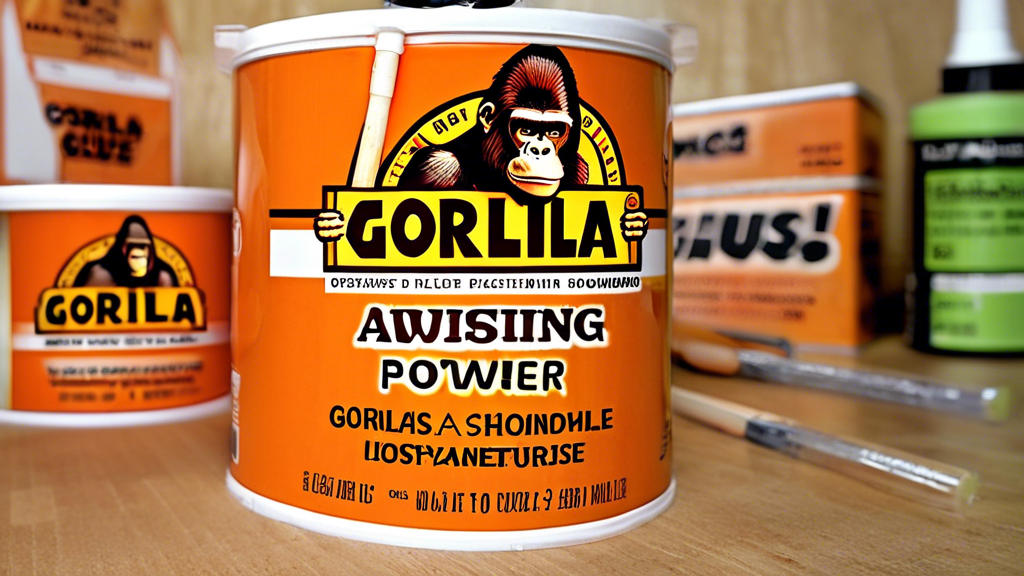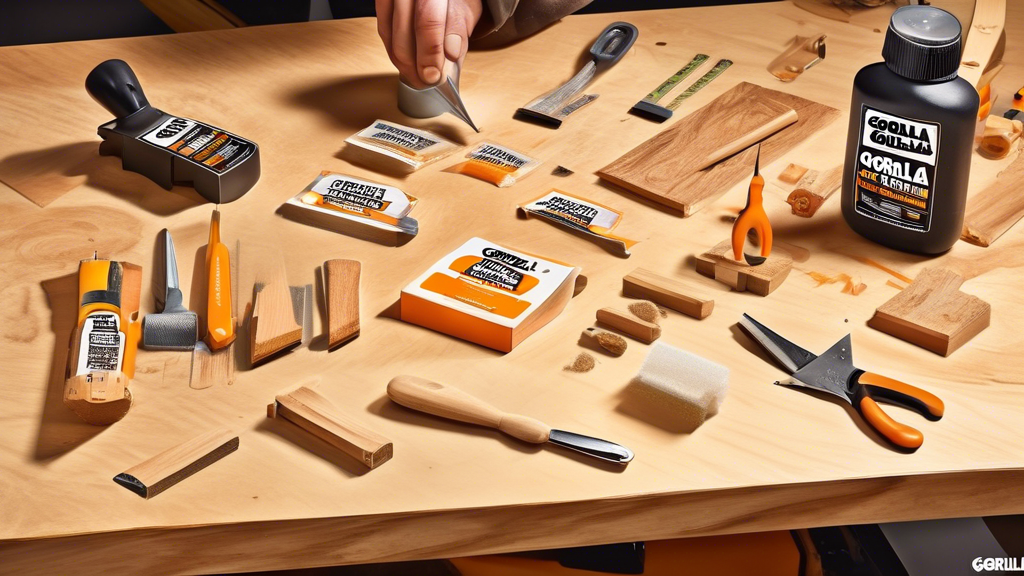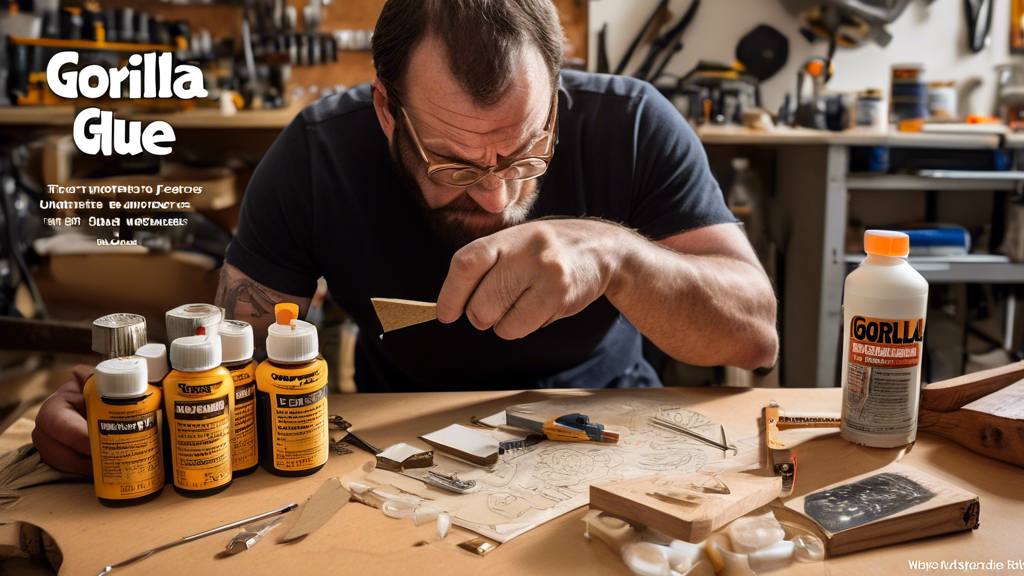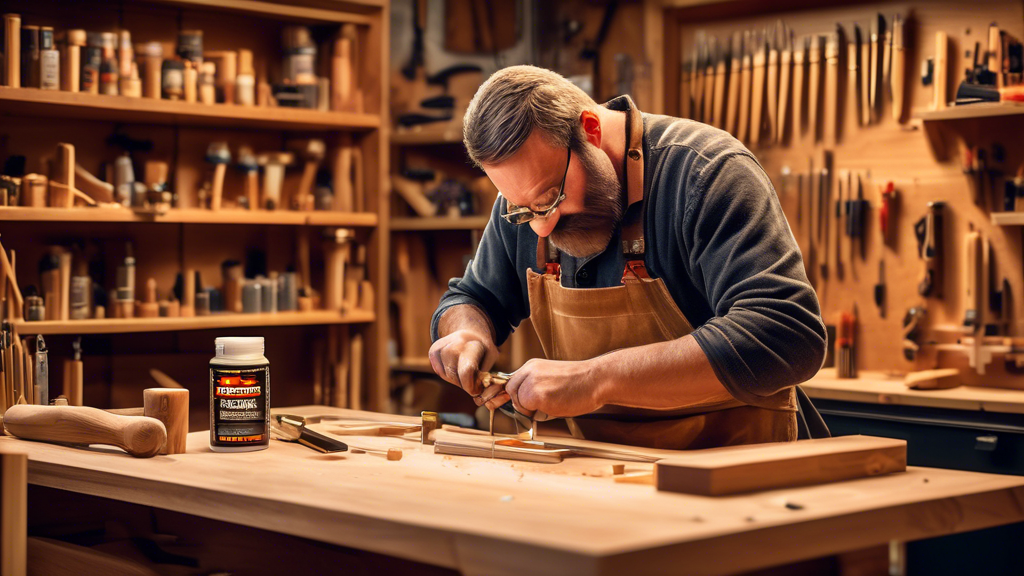How Effective is Gorilla Glue on Wood Surfaces?
When it comes to adhesives in the woodworking world, Gorilla Glue might just be the rock star of sticky stuff. You’ve probably seen it on the shelves, sporting that bright orange color and an image of a gorilla that seems unnervingly confident about its adhesive prowess. But let’s be honest—does it really live up to all the hype, particularly when it comes to wood surfaces? Whether you’re a DIY enthusiast or a seasoned woodworker, understanding what makes Gorilla Glue so popular—and whether it’s the right choice for your project—is key before you dive into gluing up your masterpiece.
So, why is Gorilla Glue such a favorite among hobbyists and professionals alike? For starters, its reputation precedes itself; this adhesive is often touted as one of the most reliable options for folks working on everything from intricate woodworking projects to quick home repairs. The real question we’re tackling today, though, is: will Gorilla Glue work effectively on wood surfaces? We’ll take a deep dive into the science of its bonding power, ensuring you’re armed with all the knowledge needed to make an informed decision for your next project.
Stick with us as we explore what gives this adhesive its grip on wooden surfaces. Think of this journey as taking a peek under the ever-enthusiastic hood of that gorilla, revealing the complex chemistry that makes this glue a favorite choice. We’ll also roll up our sleeves and get into the nitty-gritty of application methods; after all, even the best glue is only as good as your technique! You’ll get the insider scoop on prepping surfaces, applying glue with precision, and managing the sometimes sticky aftermath with ease.
And hey, don’t worry if your first attempt goes a little sideways—it happens to the best of us! I’ll be sharing some of my own comedic misadventures with Gorilla Glue, because yes, there was that one time I became more glued to my workbench than the wood pieces were to each other. So, stick around for some laughs, tips, and the reassurance that even when things get sticky, we’re all in this together, one glue-up at a time. Whether you’re working with basic clamps or the fanciest of joinery jigs, we’ve got your back.
Oh, Gorilla Glue – the sticky superhero of the adhesive aisle! This mischievous marvel has been holding things together since way back when, and let’s just say it’s earned its place as a household name. Imagine the Hulk in glue form: strong, dependable, and sometimes a bit messy if you’re not careful.
If you’ve ever tiptoed into the world of DIY projects or taken a bold leap into the arena of woodworking, chances are, Gorilla Glue has already caught your eye. Its popularity isn’t just a fluke, folks. This stuff has built quite the reputation for tackling even the most daunting of projects with its gorilla-sized grip. But, for today’s grand question: Will Gorilla Glue work on wood surfaces? Oh, you bet your sawdust-covered apron it will!
As many of you long-timers know, woodworking can sometimes feel like trying to communicate with a toddler: you think you’ve got it, but then suddenly, nothing makes sense! That’s why adhesives like Gorilla Glue can feel like a safety net. Whether you’re repairing a beloved chair or crafting a delicate scrollwork masterpiece, Gorilla Glue swoops in with unwavering strength and a reassuring pat on the back.
Now, don’t get it twisted (or glued, in this case)—understanding the material and how to use it properly are key components to success. Nobody wants to be in that sticky situation (pun absolutely intended) where the project falls apart because the adhesive wasn’t up for the challenge. So, come along ye fearless crafters and veterans of the woodsy battleground, let’s uncover the marvel that is Gorilla Glue and see exactly what it can do for our beloved wooden surfaces.
Click Here For The World’s Largest Collection of 16,000 Woodworking Plans

The Science Behind Gorilla Glue’s Bonding Power
Ah, Gorilla Glue—the sticky favorite of many a DIY enthusiast and woodworking wizard. But have you ever stopped, looked at your glue bottle, and thought, How does this magical stuff actually work? Today, we’re going to dive nose-first into the science behind Gorilla Glue’s impressive bonding power, particularly when it comes to wood. So buckle up, because we’re about to get nerdy—but in a fun way!
What’s in This Stuff Anyway?
Picture this: a mad scientist in a lab coat cackling as they mix polyurethanes. That’s not exactly how Gorilla Glue was invented, but it does contain polyurethane, a compound that’s like a superhero among adhesives. This nifty chemical composition is what allows Gorilla Glue to work its magic on wood. Polyurethane expands as it cures, filling any nooks and crannies in the wood surface, ensuring a robust and durable bond.
If adhesives had secret powers, Gorilla Glue’s would be its ability to become one with wood fibers, much like the way chocolate chips become one with cookie dough in the oven (mmm, cookies…). The glue reacts with moisture in the wood—yes, even the teeniest bit!—to form that coveted tight grip. It’s perfect for those stubborn projects that need an extra-strong hold.
How Does Gorilla Glue Get Along with Wood?
Now, let’s talk about the kind of relationship Gorilla Glue shares with wood, because let me tell you, it’s quite an affair. When applied, the glue seeps into the wood fibers, and as it cures, it locks them together like a perfect jigsaw puzzle. It’s like Gorilla Glue and wood were made for each other!
Think of it this way: Gorilla Glue is to wood as a good salsa is to chips—better together! While the glue can work wonders on many materials, wood is where it truly shines. The bond it forms is not just on the surface; it’s deeply woven into the fabric (or should I say, fiber) of the wood, creating a bond that even a woodpecker would envy.
Comparing Gorilla Glue to Other woodworking Adhesives
But wait, there’s more! You might be wondering how Gorilla Glue stacks up against the adhesive competitors lurking on your workshop shelf. Let’s pit it against some of the other contenders in the ultimate adhesive showdown:
- White Glue: The gentle giant of the glue world, perfect for lighter tasks but tends to go home early when the going gets tough. Unlike Gorilla Glue, white glue doesn’t expand, which means it’s more Ashby the Book Worm than Mr. Macho.
- Wood Glue: Ah, a formidable foe. Wood glue, such as PVA, boasts strong joints and a quick setup time, making it a favorite for many routine woodworking projects. However, it lacks the gap-filling ability that Gorilla Glue brings to the table. So when you’ve got rough or uneven surfaces, Gorilla Glue’s your buddy.
- Epoxy Resins: Quite the strong character, epoxy forms incredibly tough bonds and can even double as a wood filler. However, mixing it can feel like concocting a potion, and it often requires some extra prep and curing time. Gorilla Glue offers a simpler, single-component solution for bonding wood without the mixing hassle.
In the end, Gorilla Glue offers a unique mix of strength, versatility, and gap-filling prowess. So, will Gorilla Glue work on wood? You bet it will—like a charm!
If you ever find yourself waving a piece of wood in frustration, remember my hard-earned wisdom: sometimes the best projects grow from the stickiest situations. Trust the process, trust the glue, and laugh through the mess. Even the masters have gluey mishaps; like that time I glued my favorite shirt sleeve to a chair leg (who knew they’d get along so well?). Happy gluing, and may your projects be as strong as your coffee!
Click Here For The World’s Largest Collection of 16,000 Woodworking Plans

Application Techniques for Using Gorilla Glue on Wood
Have you ever stared at a tube of Gorilla Glue, wondered if it holds the magical formula to unite all wood surfaces, and found yourself lost in a maze of questions? Fear not, fellow wood enthusiasts! Whether you’re a green-horn whittler or a seasoned sawdust veteran, this guide will walk you through the best application techniques to ensure that your wood pieces stick together like siblings on a road trip (minus the bickering, of course).
Step 1: Prepare Your Wooden Surfaces Like a Pro
You wouldn’t wear your fanciest suit without ironing it first, right? Similarly, prepping your wood is the key to adhesive success. First, make sure both surfaces are free of debris, dust, and oil. Think of this as giving your wood a good bath—it might not squeak clean, but it’ll do. Sand the surfaces lightly if they’re slick; the goal is to give the glue some textured grooves to grip onto, kind of like how Velcro works.
Once sanded, wipe down your surfaces with a clean, dry cloth. This ensures that there’s no loose sawdust lounging around. If you’re feeling particularly prepared, you can use a tack cloth to pick up the minutiae. You’re now ready to move onto the fun part: the glue!
Step 2: Apply Gorilla Glue with Finesse
Now, don’t go overboard with the glue, even if you’re tempted to squirt the entire bottle like you’re icing a cake! Gorilla Glue expands as it cures, so a little goes a long way—think of it more like adding wasabi to your sushi than ketchup to your fries.
Spot a few dots or a thin bead line on one surface; you don’t need more than a light spread to start the magical bonding process. If you’re a visual thinker, imagine a slim ribbon of glue being unspooled like that summer camp friendship bracelet.
Place the glued surface onto the other piece of wood and align them. This might take some adjusting (or that classic carpenter “lean and squint”), but patience here will prevent future rework. Clamp the pieces tightly together. If you don’t have clamps, you can improvise with some weighty objects. Just make sure it’s stable—no one wants a toppling tower of books as their bonding buddy, after all!
Step 3: Sit Back and Let the Glue Do Its Magic
Now comes the part that many find nerve-wracking: waiting. Curing time can feel like watching paint dry, but trust in the process, folks! Gorilla Glue generally takes about 1-2 hours to dry to the touch and achieves full cure in 24 hours. In the meantime, resist the urge to poke and prod—you don’t want to disrupt the magic that’s happening at a molecular level.
If you notice some oozing (not unlike a possessed jar of peanut butter) don’t panic. Simply use a chisel or a damp cloth to gently remove any excess once the glue has set. You’ll find this easier to deal with while it’s rubbery or only partially cured.
And voila! You’ve now bonded wooden surfaces that hold together stronger than the last family game night. Whether you’re fixing a beloved rocking chair or crafting a robust table, mastering these techniques ensures that your answer to the question, will gorilla glue work on wood, is a resounding yes!
Remember, even the best-laid plans run into snags. I’ve glued my fingers to a project more than once—thought I’d invented a new appendage! But like everything in woodworking, practice and patience refine the craft. Embrace those snafus and keep at it.
Advanced Tips for the Ambitious Woodworker
For those of you who have more than just a screwdriver in your toolbox, you might be salivating at the idea of stepping up your game with some advanced techniques. Consider using Gorilla Glue as part of a two-part bonding process with mechanical fasteners. For high-stress joints, a combination of dowels or screws with glue can create an incredibly durable bond that’s practically indestructible.
If you’re utilizing more complex tools such as doweling jigs or mortise and tenon joints, gorilla glue can be a game-changer by adding that extra level of security. And, for that pristine finish, after the glue has fully cured, sand the joint to a perfect finish for smoothness and harmony.
No matter your toolkit size, Gorilla Glue is a versatile companion for woodworkers basking in their sawdust dreams. Keep crafting, keep experimenting, and remember that each swipe of the glue is a step toward your woodworking masterpiece.
Click Here For The World’s Largest Collection of 16,000 Woodworking Plans

Pros and Cons of Using Gorilla Glue on Wood Surfaces
When it comes to determining will Gorilla Glue work on wood, it’s crucial to weigh the pros and cons like two sides of a penny. A good adhesive can be the difference between your project becoming a legendary heirloom or a, well, legendary tale of woe told around the workbench. Let’s dive into the sticky details and see where Gorilla Glue shines—and where it might leave you tangled up.
Pros: Bringing the Wood to the Hood
- Super Strong Bond: When Gorilla Glue boasts about strength, it’s not flexing. This adhesive offers a bond that’s tougher than a conversation about politics at Thanksgiving dinner. Its polyurethane formula expands as it cures, allowing it to fill in every nook and cranny of those wood fibers like the perfect puzzle piece.
- Great Versatility: Think of Gorilla Glue as the Swiss Army knife in your glue arsenal. It works on a variety of surfaces, but it’s especially adept at cozying up to wood. Perfect for those times your project involves multiple materials. It’s like a rom-com where wood is the lovable old friend and Gorilla Glue is the charming protagonist.
- Water Resistance: For projects destined for the great outdoors or any environment that rivals the humidity of a greenhouse, Gorilla Glue provides a water-resistant bond. So, no need to panic if your project gets caught in a mild drizzle (or if you have a particularly splashy fish tank).
- Temperature Resilience: Planning to place your wood project in an area exposed to temperature extremes? Gorilla Glue stands up to both sizzling summers and frosty winters without losing its grip—a quality not every adhesive can boast about without their pants catching fire (metaphorically, of course).
Cons: Every Giant Has Its Achilles’ Heel
- Foamy Finish: Remember that expanding property we mentioned as a pro? Well, it can also be a con. Like your uncle at karaoke, sometimes Gorilla Glue’s performance can go a bit overboard, expanding into an unseemly mess if you’re not careful with your application. A little goes a long way, folks.
- Tricky Cleanup: Once it’s cured, getting Gorilla Glue off your skin or other unintended surfaces can be a bit like getting gum out of hair. Trust me, you’ll want to have some acetone on hand as your trusty sidekick. It’s a lesson personally learned the hard way during a teenage phase of adhesive experimentation—don’t ask.
- Clamping Required: To achieve the best bond, clamping the wood pieces together while the glue cures is essential. Think of it as the romantic weekend escapade your wooden lovebirds need to keep their relationship strong. No clamps? No problem, but you might find your pieces parting ways after a spat.
- Drying Time: Patience is a virtue, and alas, you’ll need a bit of it. Gorilla Glue’s curing process isn’t instant; it’s more of a leisurely Sunday afternoon stroll rather than a race to the finish line. You’ll want to give it at least 24 hours to reach the full might of its bonding potential.
Word from the Workshop: Real-Life Testimonials
Jack, a woodturner and weekend warrior, shares his tale: “Tried Gorilla Glue on a birdhouse project, and despite a foamy mishap that left it looking like a snow-covered chalet, it held up through two winters. I call that a win!” Meanwhile, seasoned cabinet-maker Susan notes, “Great for some jobs, but watch that expansion! Had to redo part of a table once because it turned into a science experiment.”
Whether you’re a beginner trying to find your footing or a veteran seeking a trusty companion for your creative endeavors, understanding the strengths and weaknesses of Gorilla Glue on wood surfaces will help you decide if it’s the right adhesive for your project. Remember, every project teaches something new, and even entertaining mishaps can lead to expert wisdom.
In conclusion, Gorilla Glue, with its sturdy reputation and sticky prowess, proves to be a formidable contender in the toolbox of any woodworker, whether you’re a DIY dabbler or a seasoned sawdust slinger. When it comes to the million-dollar question—will Gorilla Glue work on wood?—the answer is a resounding yes. Its unique chemical makeup creates an adhesive bond that’s as strong as a lumberjack’s handshake, snugly locking wood fibers into place as if they’ve been lifelong friends.
The secret sauce of Gorilla Glue is its moisture-activated polyurethane formula, which forms a bond so reliable you’d think it had taken a blood oath with the wood grains. This makes it a standout choice compared to other adhesives, offering woodworkers the peace of mind that their creations will stand the test of time—much like that birdhouse in your grandpa’s yard that’s weathered more storms than a pirate ship.
Applying it, as with any potent tool, requires a little finesse. Remember the golden rules: a little moisture goes a long way, excess glue is not your friend (unless you fancy spending your afternoon chiseling dried globs off your project), and clamping is key for that top-tier bond. Patience is the name of the game here, as letting the glue cure without disturbance ensures your masterpiece stays in one piece, rather than taking an unexpected visit to Splitsville.
Of course, with great power comes great responsibility, and Gorilla Glue has its share of quirks. While it might be the Hercules of household adhesives, it can be a tad frothy and stubborn once cured, so measure twice, glue once! Whether you’re attaching a table leg or creating an intricate inlay, preparation is your best friend.
At the end of the day, like a wise old carpenter once didn’t say, it’s not the size of your glue bottle, but how you use it. Gorilla Glue offers a wealth of opportunity for woodworkers seeking a dependable bond—but remember, it pays to play by its rules. Embrace the learning curve, and soon you’ll be bonding like a pro, confident that your creations will be a testament to both your skill and the adhesive heroics of Gorilla Glue. Keep those clamps handy, and don’t forget to wipe away any stray spills—a lesson I learned after a rogue drop transformed into a small fortress on my workbench! Happy gluing, fellow wood whisperers, and may all your joints be as steadfast as your passion for woodworking.
Click Here For The World’s Largest Collection of 16,000 Woodworking Plans

